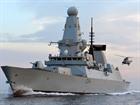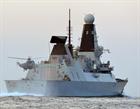854NAS ASaC Sea King links up with HMS Diamond
Even though Type 45 destroyers have been around for a good four years and Bagger Sea Kings have been flying since the mid-80s in various forms, never the twain have met…until now. They did so not off Cornwall, home to the Baggers – officially Sea King Airborne Surveillance and Control – or Portsmouth, home to five of the six Type 45s in Royal Navy service, but 3,500 miles away on deployment in the Gulf. HMS Diamond was the 45 in question. The Sea King came courtesy of 854 Naval Air Squadron, typically based at Culdrose.
The Baggers – the name comes from the distinctive black sack or bag which contains their radar – are the ‘eyes in the sky’ of the Fleet, used to detect potential threats. And the Type 45s are the ‘eyes on the surface’ of the Fleet, used to detect aerial threats scores of miles away. So the combination of the two should be quite impressive. Time to find out.
The Baggers have built up a wealth of experience over land (Iraq and Afghanistan) and sea (Libya) over the past decade playing key roles in ground and aerial operations respectively; the Culdrose helicopters are committed currently over Helmand and aboard the Cougar task group exercising in the Adriatic. Using the techniques honed from these deployments they are bolstering surveillance at sea by demonstrating their ability to detect even small contacts at range and report them to friendly units.
As for Diamond, well she’s on her maiden deployment to the Gulf region, following in the footsteps of HMS Daring which deployed there earlier this year. She’s worked with the US Navy and their carrier battle groups, plus the UK’s allies in the Middle East, and carried out maritime security operations.
“The complementary capabilities of Type 45 and Sea King Mk 7 mean that we can assess air and surface activity over a wide area of the ocean,” said Diamond’s Commanding Officer Cdr Ian Clarke. The physical act of landing a Sea King on the back of a Type 45 shouldn’t be too challenging as operating helicopters at sea goes; the destroyer’s flight deck is large enough to accommodate a Chinook. But with this maiden landing on an autumn day in the Gulf, Diamond flashed up her funky green neon lights (technical term) to aid the Bagger’s approach. The lights – the correct term is Improved Approach Lighting – are green LEDs fixed to the hangar and quarterdeck of Type 45 destroyers and Type 23 frigates to help pilots on final approach at night or in poor visibility. The centre light over the hangar door gives the aircrew a fixed visual reference to indicate the movement of Diamond’s flight deck. In this instance, the lights were switched on to illuminate white ‘bum lines’ across the flight deck; the lines are nose and tail reference tools for pilots so they can set down their helicopter safely. Which the Bagger did.
"I enjoy working with the aviation team onboard and supporting our Lynx, but the Sea King Mark 7 brings with it a different set of challenges and I am glad to be the first Flight Deck Officer to land one on a Type 45,” said Diamond’s PO(Wtr) Anthony James who guided.
He and his shipmates are in the closing stages of Diamond’s inaugural tour of duty; the destroyer is due home in Portsmouth before Christmas.


